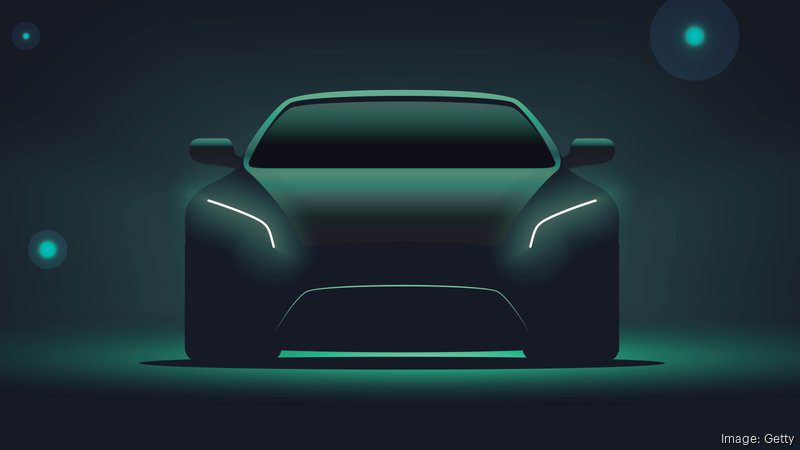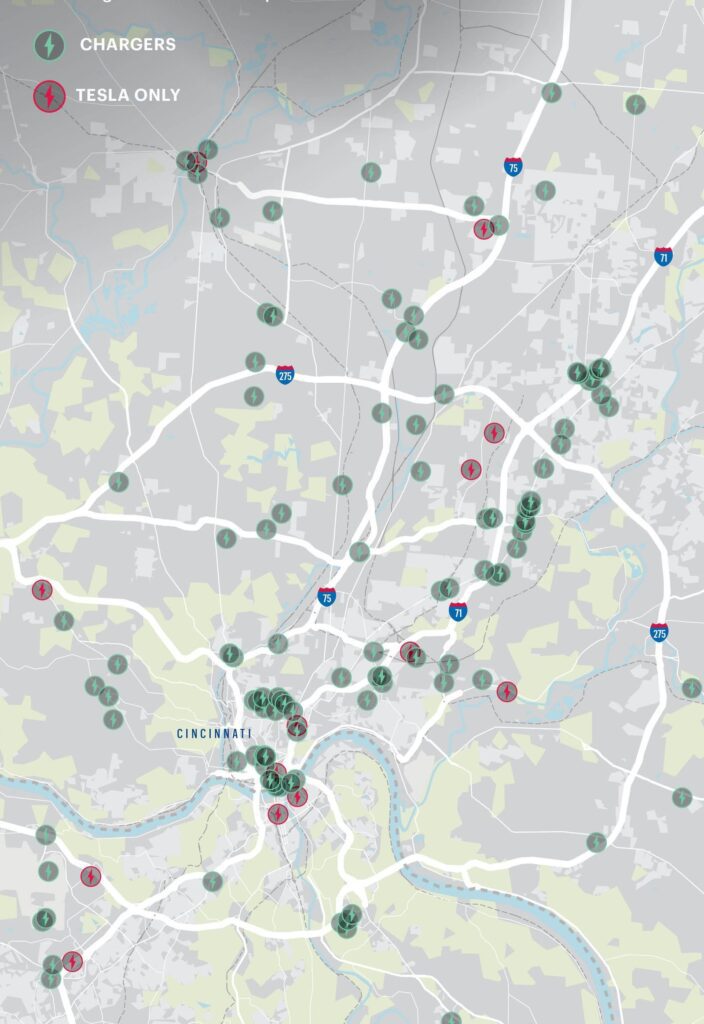Joanne Drilling
Data editor – Cincinnati Business Courier

You think we could take this out on the highway?” I asked, casually looking over at Rob Bernard, a sales associate from Porsche of the Village, just off Mariemont Square. We’d been quietly tooling around Indian Hill for about 20 minutes. I was behind the wheel of a Taycan 4S Cross Turismo, Porsche’s only all-electric vehicle, and dying to feel the fast-twitch acceleration.
“I’ve got a better idea,” Bernard said. “Let’s test out ‘launch control.’”
I bit back my kid-in-a-candy-store grin. Five minutes later, we sat at the base of a deserted on-ramp.
“Floor the brake with your left foot,” Bernard instructed. “With your right foot, do the same to the accelerator. When I say go, you’re going to immediately lift your foot off the brake. But whatever you do, don’t let up on the gas.”
I looked down at the dash screen. It flashed “launch control activated.” When Bernard gave the signal, I released the brake. The car tore up the ramp as our heads snapped back against the custom headrests. I giggled maniacally as we flew past 60 mph in just under four seconds.
The Porsche Taycan I drove retails for $113,000, which considering its competition, isn’t outrageous. Later that same day, I got behind the wheel of a sultry Audi e-tron GT Quattro (MSRP $104,500) from Audi Connection in Montgomery for an equally exhilarating drive. Both cars married cutting-edge EV technology with sports car styling and handling to grand effect. But are luxury car manufacturers hopping into the market as a complement to their traditional gas engines or do they see electric vehicles as the future of the industry? And what does that mean for EV pioneer Tesla?
“Porsche is in the camp of vibrations, rumbling and feeling the gears change. In EV, you’ll find there’s not a lot of that,” said AJ Murphy, general sales manager at Porsche of the Village. “Very early on, Porsche wondered where our place was with EV. Are we green or performance? Now, we’re all in, but I think it’s largely thought of as a performance enhancement feature.”
Audi Connection’s EV specialist, Frank Winstel, believes the German automaker is preparing for a “100% electric world.” Fifty percent of Audi’s global sales are in China, where the EV initiative has gained significant traction due to the country’s environmental woes.
“Everything Audi has on the books will have an electric variant,” Winstel said. “By 2025, we were supposed to have 30% of the brand electric, but Covid jacked with that a bit. But I’m going to say probably by 2035 it’ll be done.”
While Tesla dominated the early EV market, traditional automakers refuse to be left in the dust. Last year, the industry poured $1 trillion into the shift from combustion engines to electric. In 2021, EVs accounted for 3% of all automobile sales. By late 2022, sales hit 6% as others piled into the market. Then just under a month ago, Tesla shocked the industry by slashing prices up to 20%, making the Model Y eligible for a $7,500 federal tax credit and aggressively positioning its vehicles for the coming price war.
But all EV purchasing experiences aren’t created equal. Tesla’s direct-to-consumer model is a far cry from the customer service-driven dealership experience. Test drives must be scheduled online, and delivery centers are staffed by assistants who can explain operational basics, but every single aspect of the purchase, including financing, must be conducted via their website. The company declined to comment.
The Tesla Model S I drove starts at $96,630 but can easily reach $150,000 with options, making it comparable to the six-figure Audi and Porsche EVs. At the opposite end of the spectrum is the Kia EV6 with 167 hp (the Model S has 670 hp) and a price tag of $43,650, still almost double that of the base model Toyota Camry.
“If an average electric vehicle MSRP (manufacturer’s suggested retail price) is $60,000, that separates a lot of people out of the mix, especially when you consider the median income is $44,000,” Winstel said.
Going electric may still be a luxury for the average driver, but for the technologically adventurous or the performance auto junkie, it’s inarguably the next frontier. “You can move away from fossil fuels and have a good time doing it,” Murphy said. “I’ve always been a car nut. My first (EV) was a hybrid and I just wanted to learn. What I discovered is that pure EV made perfect sense for my lifestyle.”
Murphy also believes the region is on target in embracing electric. “Cincinnati is a healthy EV market in this part of the country. I personally find the size of the city, traffic volume and travel distances to be perfect for EV driving. Our infrastructure is growing rapidly, and residential electrical companies are installing more in-home chargers than ever before,” he said. “There are large investments in EV infrastructure by some of the biggest names in (town) and well-known individuals are quietly investing in EV startups. We’re seeing the city’s commitment with free parking (for EVs with a permit), consumer education initiatives and replacing gas fleets with EV models.”
Much like my own Taycan test drive, the EV market is headed toward full “launch” mode. Will 2023 be the year consumers finally lift off the brake? Will traditional auto makers give Tesla a real run for its money? Better fasten your seat belts; we’re gearing up for a wild ride.
Imbalance of Power
According to a recent survey by professional services company KMPG International, auto executives believe half their sales will be electric by 2030. If that’s the case, charging infrastructure must scale quickly to meet demand. Is our region ready?
Currently, most stations are located near the urban core and on Cincinnati’s Eastside. While availability may correlate with current EV ownership, drivers (despite their ZIP code) need better access if their to travel farther afield. Local charging startups want in on the action. Edge Energy manufactures a plug-and-play fast charger designed specifically for edge-of-grid locations like small towns and state parks, while Electrada has targeted community hubs like Findlay Market and Northern Kentucky University for its charging stations.
Opportunity also awaits for owners of commercial real estate interested in tax breaks. To incentivize businesses to construct EV charging stations, generous tax credits, rebates and grants are currently available. The federal 30C Alternative Fuel Infrastructure Tax Credit will give qualifying businesses a 30 percent tax credit up to $100,000, to purchase and install EV chargers. On the state level, AES Ohio has been offering rebates of $10,000 for installation of Level 2 chargers and $75,000 for DC fast chargers available to the public.
Charging stations aren’t one-size-fits-all. Here’s what to know before you go.
- Level 1 AC: This charger plugs into the standard 110 outlet and is popular for residential use. But at less than 2 kilowatts of power, don’t expect speed. Charging from empty may take several days.
- Level 2 AC: The most common commercial car charging system, this model requires a 240-volt hookup (think laundry dryer plug) and can charge a fully depleted EV battery in four to 10 hours. It can also top off a partial battery in less than an hour, making it ideal for drivers who need to stop and shop.
- DC Fast Chargers (DCFC): Ultimately the most efficient – DCFCs can charge an empty battery in under an hour – they’re also the most expensive to install and consume between 40 and 400 kilowatts of direct current power. Extensive installation protocol is required, as are consumer safety measures. Under the DCFC umbrella, there are three types available. Tesla produces a proprietary connector and Nissan has historically been behind CHAdeMO (standard DC) chargers, although they have recently pulled back from the project. Currently, CCS is the main non-Tesla DC charger, although Tesla plans to release a CCS adapter that will allow non-Tesla vehicles to charge using their supercharger network later this year.
Four tips for secondhand buyers
As leases are returned and older models traded in, the market for pre-owned EVs is ever-expanding. Recurrent, a Seattle-based startup that uses artificial intelligence to provide increased transparency in EV purchases, has tracked secondhand sales and found that a third of the 160,000 EVs sold in the first three months of 2022 were pre-owned. But before you go green, there are additional criteria to consider beyond budget and a Carfax report. Consumer insights company J.D. Power recommends four top tips for secondhand shoppers.
- Be aware of battery degradation: Consider the iPhone – a brand-new 14 Pro stays charged for a day and a half while an iPhone 8 seems stuck on the struggle bus after four hours. The same applies to an EV battery, but on a much larger scale. If the battery loses 10% of its capacity over time, the car will travel 10% less on a full charge.
- Understand EV-specific warranty details: Buy certified pre-owned for peace of mind. Tesla offers limited coverage for its used vehicles and extends the warranty from the original four-year, 50,000-mile basic offering with an additional year or 10,000 miles. Chevrolet transfers its EV warranty to the new owner but will only replace the battery if capacity is less than 60% of what it was new. Ford and Hyundai also extend existing warranties for batteries and other components.
- Utilize government incentives: For 2023, there remains a $7,500 federal tax credit available to new EV owners. Caveats now include final assembly in North America, purchase price under $55,000, and a family income below $300,000 or individual under $150,000. The passage of the Inflation Reduction Act last August extended savings to used EV owners, offering $4,000 or 30% of the purchase price with some stipulations. Purchase price must be below $25,000, the vehicle must be more than two years old and sold by the original owner. Individual income must be below $75,000, or for a family, below $150,000.
- Keep operating systems current: Again, think iPhone. Once software updates are available, it’s best to install. When purchasing a used EV, it’s essential to reset personal data from the previous owner so apps can sync. Keep in mind, many new EVs come with automaker charging credits through networks such as Electrify America or ChargePoint. But a new, second-hand owner will need to add their own personal details to the car’s infotainment screen and connected app to pay and start charging at compatible stations.




